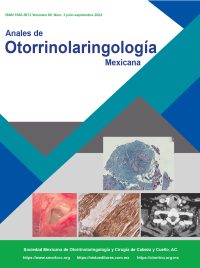An Orl Mex. 2024; 69 (3): 209-217. https://doi.org/10.24245/aorl.v69i3.9552
Rodolfo Moreno Sauceda,1 Mariana Durán Ortiz,2 Fernando Pineda Cásarez,2 María Teresa Sotelo Ramírez,2 Federico Agustín Moscoso Cabrera,1 Luis Carlos Sánchez Paz,1 Guillermo Antonio Ramírez1
1 Médico residente de Otorrinolaringología y Cirugía de Cabeza y Cuello.
2 Médico adscrito al Servicio de Otorrinolaringología y Cirugía de Cabeza y Cuello. Profesor de posgrado.
Facultad Mexicana de Medicina, Universidad La Salle. Hospital Regional General Ignacio Zaragoza, ISSSTE, Ciudad de México.
Resumen
OBJETIVO: Conocer la variabilidad en la profundidad del seno sigmoides dentro de la cavidad mastoidea en huesos temporales de acuerdo con las clasificaciones de Sun y colaboradores, Ichigo y su grupo y Melo y colaboradores.
MATERIALES Y MÉTODOS: Estudio descriptivo, no experimental, retrospectivo de naturaleza cuantitativa, en el que se evaluaron tomografías computadas de pacientes mexicanos mayores de 18 años derechohabientes del Hospital Regional General Ignacio Zaragoza (ISSSTE), Ciudad de México, que acudieron a consulta externa de Otorrinolaringología de junio de 2022 a marzo de 2023. Se calculó la prevalencia de cada clasificación y la distribución de las variables demográficas, se midió el grado de relación entre los conjuntos de datos de cada clasificación del seno sigmoides mediante el análisis de coeficiente de correlación.
RESULTADOS: Se analizaron 105 pacientes con edad de 18 a 84 años; el estudio mostró variabilidad en la profundidad del seno sigmoides dentro de la cavidad mastoidea en huesos temporales entre los pacientes en posición y forma de acuerdo con el sexo y lado del oído. Se observó que la clasificación más frecuente del seno sigmoides en el oído derecho fue posición lateral, tipo 3 y forma protrusiva; en el oído izquierdo fue posición lateral, tipo 2 y forma de platillo. El grado de relación del oído derecho fue estadísticamente significativo entre la propuesta de Sun y su grupo e Ichigo y colaboradores.
CONCLUSIONES: El oído derecho mostró el seno sigmoides más protruido y es más frecuente que en mujeres esté más profunda la posición del seno sigmoides respecto a los hombres.
PALABRAS CLAVE: Hueso temporal; tomografía computada; Otorrinolaringología.
Abstract
OBJECTIVE: To know the variability in the depth of the sigmoid sinus within the mastoid cavity in temporal bones according to the classifications of Sun et al, Ichigo et al and Melo et al.
MATERIALS AND METHODS: Descriptive, non experimental, retrospective, quantitative study was done, assessing computed tomographies of Mexican patients older than 18 years of Regional Hospital General Ignacio Zaragoza (ISSSTE), Mexico City, who attended to external consultation of Otorhinolaryngology from June 2022 to March 2023. Prevalence of each classification and the distribution of demographic variables were calculated, the degree of relationship among the data sets of each sigmoid sinus classification was measured by correlation coefficient analysis.
RESULTS: A total of 105 cases of patients ranging in age from 18 to 84 years were analyzed; the study showed variability in the depth of the sigmoid sinus within the mastoid cavity in the temporal bones among patients in position and shape according to sex and side of the ear, it was observed that the most frequent classification of sigmoid sinus in the right ear was lateral position, type 3 and protrusive shape, in the left ear it was lateral position, type 2 and saucer shape. The degree of relationship of the right ear was statistically significant between the proposal of Sun et al and Ichigo et al.
CONCLUSIONS: The right ear showed the most protrusive sigmoid sinus and it is more frequent that in women the position of the sigmoid sinus is deeper than in men.
KEYWORDS: Temporal bone; Computed tomography; Otorhinolaryngology.
Recibido: 7 de febrero 2024
Aceptado: 2 de agosto 2024
Este artículo debe citarse como: Moreno-Sauceda R, Durán-Ortiz M, Pineda-Cásarez F, Sotelo-Ramírez MT, Moscoso-Cabrera FA, Sánchez-Paz LC, Ramírez GA. Variabilidad de la profundidad del seno sigmoides en huesos temporales por tomografía simple. An Orl Mex 2024; 69 (3): 209-217.


